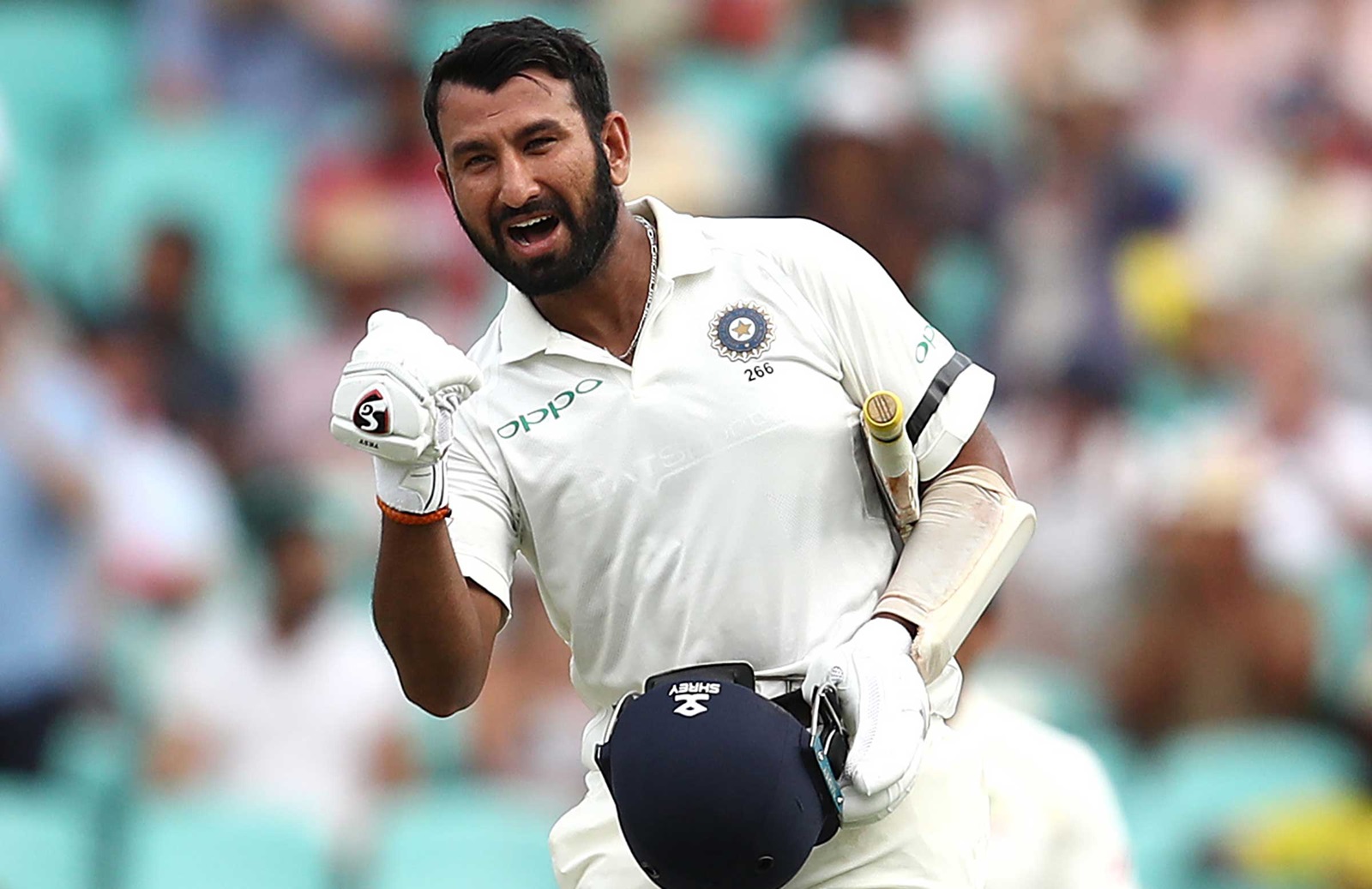Pujara. He is an enigma isn’t he? It is hard not to criticise Pujara and at the sametime, it is hard not to praise him either. He is instrumental in India winning games and at the same time he is instrumental in India not taking advantage or not putting the pressure back on the bowlers. Pujara divides opinion. It is not new. Pujara has always been someone who takes his time to settle down. He builds his innings like a tall skyscraper brick by brick that reaches a crescendo when he feels completely in control. Pujara has all of the shots that is on the coaching manual. He does not pull the ball often but he has shown that he can play that shot.
Pujara wasn’t always this bad
Now, why am I describing these in the past tense? It is because off late, he seems to have slowed down even more. In the sense, he is slower by his own standards. It almost seems like he thinks the more he stays on the wicket, the runs will come irrespective of whether he tries to score or otherwise. He does not seem to understand that one of his role is to score runs and ensure that the team gets a good start. It is time he understands that he is wrong.
Pujara has never been this bad. Yes, there was a period when he wasn’t able to make a meaningful contribution apart from South Africa all those years ago. He had a horror run in Australia, New Zealand and England. He even claimed despite such failures that he cannot score double hundreds everytime he walks to the wicket. This despite scoring only 2 fifties in 20 innings. This was back in the year 2014.
Some of the comments from former batsmen does not inspire confidence
“At times I feel disappointed that I couldn’t capitalise and score a big one,” Pujara said. “But it’s a game of cricket. You can’t score double-centuries all the time.
He lost his spot in the team after such a horrendous run. Even then, he wasn’t this bad. He had a decent strike rate of 40+. By Pujara’s standards, this was really good. Infact, until 2017, he had a good strike rate. The rot seems to have set at the beginning of 2018 and more damagingly, for him and for India, from 2020 onwards. His strike rate over the last couple of years is at 30. He just couldn’t find ways to score runs. The moment Pujara walks in, he ensures that the entire scoring rate is completely killed. Infact, he murders the scoring rate. Pujara is only intent on occupying the crease.
He seldom gives the impression of someone who wants to score. If one were to ask Hazlewood about Pujara, he will say that Pujara bats and bats and bats. Yes he does bat but only to be on the wicket. During the last couple of years, Pujara seems to have forgotten the offside. Unless the ball is pitched on the legs, he struggles. If the pitch or the bowling is difficult, it gets even worse.
“Out of my memory, I just remember Pujara playing great off his legs. Very, very good off his legs and eyes underneath the ball. But I do remember him playing some magical cut shots and back foot drives. I’m so used to him rocking onto his back foot and playing with his hands and good feet movement. He’s kind of lost that part of his game.
This was Dale Steyn who remembers his playing career while bowling to Pujara.
Pujara’s lack of impact during the WTC finals
The recent WTC finals is a good example. India got off to a good start under extremely challenging conditions for the batsmen. In walks Pujara after Rohit Sharma falls, immediately, the scoring rate drops to a trickle. He completely stopped scoring. As a result, the New Zealand bowlers, who were struggling for line and length until then, suddenly were able to bowl to a plan. This was because Pujara allowed them to bowl in the right areas. It was atrocious batting.
Virat Kohli wants the batmen to look for runs and not be worried about getting out. He is correct. Ofcourse, he was also guilty in both the innings in not trying to score. That is another matter. It will not be an understatement to say that Pujara actually was responsible for India succumbing to a low score and losing the finals.
Allan Border, the former Australian captain has opined that Pujara gets stagnated at the crease. This was during the Australian series in 2020.
“He’s almost scared to play a shot, isn’t he? He’s playing to survive rather than looking to score”
Ricky Ponting, who knows a thing or two about batting says that Pujara does not hurt the Australians because of his slow batting.
“To bat like he did today, finally get a great ball from (fast bowler Pat) Cummins, although he got 50, he just hadn’t hurt the Australians at all. In fact, batting like he did actually kept Australia in the game.”
Ponting also makes a pertinent point that if someone bats for so long, he must ensure that he scores a 100 or 150 to justify his long stay. That is where Pujara has failed. Time and again.
However, Pujara is adamant
“I just have to bat in the manner I know to bat, even as a batting unit, you need to build partnerships and bat well as a unit,” Pujara said.
The fact is, he has changed his batting and that is proving detrimental to the team. He does not seem to realise that this is not the way he used to bat. He used to be much more positive in his approach. The sooner he realises this the better it is for him. No one is expecting him to score at a strike rate of 80. It is only reasonable to expect him to score at 45 or 50. His adamant attitude of not wanting to change seems to indicate a mind that is not only refusing to listen to reason but is refusing to change. This is a serious problem. Indian management will do well to make him understand.
Critics of Pujara
Critics of Pujara points out that because of his ultra slow batting, first, he allows the bowlers to bowl the way they want to bowl. He helps them to get their line and length perfect and as a result the bowlers gain so much confidence that they are able to dictate terms to the Indian batsmen.
Second, as Ponting says, when Pujara bats, India would not have progressed at all despite playing for over 50 overs. Allan Border used to say that one must always add a couple of wickets to the current score and see where the team is placed. If you take that into consideration, after 50 overs, India are about 110-120 and if you add a couple of wickets, it is already 120/3. That is not a flattering scorecard.
Third, he makes the opposition much tougher than they actually are. Yes, this is true. By allowing the bowlers to settle, Pujara actually makes runs scoring difficult even for his partners. The partners are under the illusion that the bowling is tough or the condition is challenging when it is absolutely possible to overcome them. A sort of fear creeps into the other batsmen. Being one of the senior batsman, Pujara just cannot get away with not scoring runs. Infact, he must score the bulk of the runs and must not pass on the scoring to youngsters like Pant or Vihari.
Supporters of Pujara are of different opinion
Pujara by batting for time actually makes the bowlers so tired and it is easier for his partners to score freely. They will happily site the example of his batting in Australia. One at Sydney which helped India to save the game. Pujara played a major part in the 2nd innings that ultimately, Vihari and Ashwin were left with just 40 overs to bat through. At Brisbane, Pujara held one end tight so that Pant could play his natural game and thereby he was able to win the game and the series. However, he played so long and so slow in the first test that when he got out, India hadn’t got anywhere.
It is absolutely fine if Pujara plays in this way when India are trying to save the test. It is not acceptable when India is trying to set the pace. This is what Pujara is unable to differentiate.
It is time Pujara understand his responsibility and starts to score runs. Else, it is time for him to make way for another batsman.



